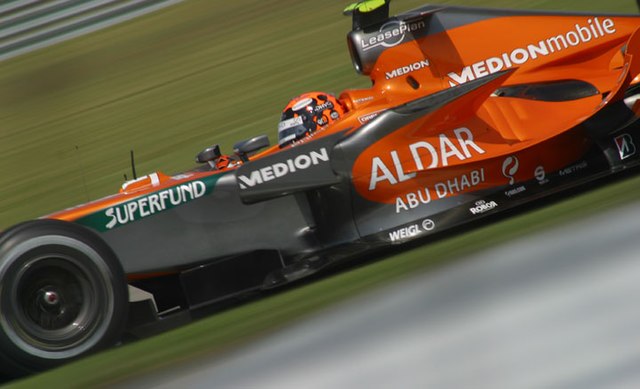The Spyker F1 Team, known as the Etihad Aldar Spyker F1 Team for sponsorship reasons, was a Formula One team that competed in the 2007 Formula One World Championship with a Dutch licence. It was created by Spyker Cars after their buyout of the short-lived Midland F1 team. The change to the Spyker name was accompanied by a switch in racing livery from the red, grey and white previously used by Midland, to an orange and silver scheme—already seen on the Spyker Spyder GT2-R—orange being the national colour and the auto racing colour of the Netherlands. At the end of the 2007 season, the team was sold to Vijay Mallya and renamed Force India.
Midland M16 livery after the purchase by Spyker
A Spyker in 2007 livery
Spyker during the 2007 season
2007 Formula One World Championship
The 2007 FIA Formula One World Championship was the 61st season of FIA Formula One motor racing. It featured the 2007 FIA Formula One World Championship, which began on 18 March and ended on 21 October after seventeen events. The Drivers' Championship was won by Ferrari driver Kimi Räikkönen by one point at the final race of the season, making Räikkönen the third Finnish driver to take the title. An appeal by McLaren regarding the legality of some cars in the final race could have altered the championship standings, but on 16 November, the appeal was rejected by the International Court of Appeal, confirming the championship results. Räikkönen entered the final race in third position in the drivers' standings, but emerged as champion after the chequered flag, a feat first accomplished by Giuseppe Farina in 1950.
Kimi Räikkönen, the 2007 World Drivers' Champion with 110 points, won the title in his first year with Ferrari. He remains the last Ferrari driver to win a championship.
Lewis Hamilton, runner-up with 109 points. Hamilton recorded nine consecutive podium finishes in his debut season, more than any other rookie in Formula One history. He also became the youngest runner-up until Sebastian Vettel in 2009.
Fernando Alonso, the defending double World Champion, also recorded 109 points but was placed 3rd through count-back.
Kimi Räikkönen (pictured in 2002) left McLaren at the end of the 2006 season to join Ferrari before the season.







